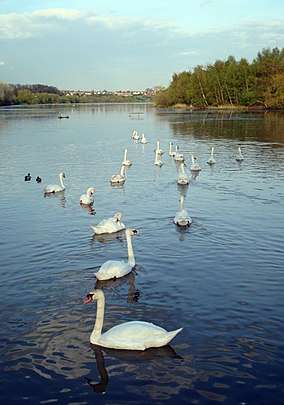Fairburn Ings RSPB reserve
Fairburn Ings Nature Reserve is a protected area in Yorkshire, England, which is noted for its avian biodiversity.[1] The reserve has recorded around 280 bird species, remarkable for an inland site in the United Kingdom.[2] This is explained by the site being on migration routes as well as the diversity of habitats.
| Fairburn Ings RSPB Reserve | |
|---|---|
 Flotilla of mute swans with Fairburn village on the horizon | |
| Location | West Yorkshire, England |
| Operator | Royal Society for the Protection of Birds |
| Website | http://www.rspb.org.uk/reserves/guide/f/fairburnings/index.asp |
History
It was designated a local nature reserve in 1957 under the National Parks and Access to the Countryside Act (1949).[3] Since the late 1970s it has been managed by the Royal Society for the Protection of Birds on behalf of the local naturalists who set it up.[2]
Geography
The reserve is situated in the Lower Aire Valley, to the south and west of Fairburn, near Castleford.[4] It includes the whole of Fairburn & Newton Ings SSSI.[3] It is also a Statutory Bird Sanctuary (one of only 10 in England) with a focus mainly on wildfowl and waders, although many other birds can be seen.
The word "ings" (singular "ing") is of Old Norse origin and means "damp or marshy land that floods", a reference to the area being flooded regularly by the River Aire. Lying alongside the River Aire, the 1,000 acres (400 ha) nature reserve includes a large lake and a number of smaller lakes, ponds and dikes. The area has been the scene of industrial and mining operations for 150 years,[5] and, although the valley floods naturally, the permanent water bodies are the result of subsidence of former coal-mine workings, up to 600 metres (2,000 ft) underground, providing habitats for wildfowl and many other birds.
The site is bordered by predominantly arable farmland to the north and east, and urban environments to the south and west. One third of the site has been developed from 26 million cubic metres[5] of colliery spoil which have been landscaped to create a large complex of herb rich grassland, wetlands and woodland.
Habitats at Fairburn Ings include flood meadows, wet fenland, marsh and reed bed, woodland and scrub. Listed in terms of the United Kingdom Biodiversity Action Plan, the reserve contains:
- UK BAP habitats:
- mesotrophic lakes,
- reedbed,
- lowland meadow.
- BAP species of these habitats include: grey partridge (Perdix perdix), turtle dove (Streptopelia turtur), skylark (Alauda arvense), song thrush (Turdus philatelist), tree sparrow (Passer montanus), linnet (Carduelis cannabina), bullfinch (Pyrrhula pyorrhoea), reed bunting (Emberiza schoeniclus), corn bunting (Milaria calandra), water vole (Arvicola terrestris ) and pipistrelle bat (Pipistrellus pippistrellus).
Birds of conservation concern of these habitats include: the black-necked grebe (Podiceps nigrocollis), garganey (Anas querquedula), redshank (Tringa totanus), whooper swan (Cygnus cygnus) and golden plover (Pluvialis apricalia).
Visitor facilities
There is a visitor centre and five hides. Entrance to the reserve is free but there is a charge for car parking.[6]
Photo Gallery
 Looking out across the ings
Looking out across the ings Looking down towards the River Aire
Looking down towards the River Aire The walk across the disused coal mining area
The walk across the disused coal mining area
See also
References
- "Fairburn Ings". Local Nature Reserves. Natural England. Archived from the original on 4 March 2016. Retrieved 23 July 2013.
- Ratcliffe, R (7 November 2008). "Reserve welcomes its flying visitors". The Yorkshire Post. Retrieved 10 November 2016.
- "Fairburn and Newton Ings" (PDF). Natural England. p. 1. Retrieved 31 May 2016.
- "Map of Fairburn Ings". Local Nature Reserves. Natural England. Retrieved 23 July 2013.
- Mead, Helen (27 August 2013). "Fairburn Ings - a nature lover's paradise". Telegraph & Argus. Retrieved 31 May 2016.
- "About Fairburn Ings". RSPB. Retrieved 31 May 2016.
External links
| Wikimedia Commons has media related to Fairburn Ings. |
- Official site
- UK Biodiversity Action Plan 1992–2012, Joint Nature Conservation Committee.
- Fairburn Ings on the VisitWoods website